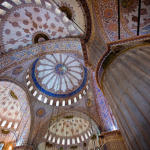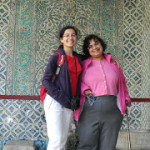Augustine of Hippo: He being dead, yet speaketh. A Guest Post by Joshua Lake
He looks to You for friendship.
He makes enemies only to protect Your honor.
The one fixed in You sees his earthly loves as beloved in You.
You alone cannot be lost; You only are certain.
Our God are You who made heaven and earth.
You fill them with works of Your creation.
– Confessions, page 59 (Modern English Version, Baker Book House: 2005).
A Dream-Crusher or Dream-Nurturer?
Never Believe the Pronouncements of Theologians if They Conflict with Your Intuitive Moral Sense

Never believe pronouncements of theologians if they conflict with your own moral sense.
I am re-reading John Piper’s extraordinary, honest and remarkably self-analytical account of his racist past.
Jesse Jackson grew up 3 miles across the town from Piper, in Greenville, South Carolina.
Piper writes: Our worlds were so close and yet so far apart. His mother, Helen, loved the same Christian radio station my mother did—WMUU, the voice of Bob Jones University. But there was a big difference. The very school that broadcast all that Bible truth would not admit blacks. And the large, white Baptist church four miles from Jesse Jackson’s home wouldn’t either. Nor would mine.
This was my hometown. And there is no mystery in it as to why a young black man growing up there—or a Martin Luther King growing up in Atlanta a generation earlier—would get his theological education at a liberal institution (such as Chicago Theological Seminary or Crozer Theological Seminary). Our fundamental and evangelical schools—and almost every other institution, especially in the South—were committed to segregation.
Theologians, 50 years ago, were committed to segregation, with a pastiche of Biblical quotes as a theological underpinning!
Treat the pronouncements of theologians with a healthy scepticism.
Encounter Scripture, God, Jesus and the Holy Spirit for yourself.
* * *
Piper goes on, I was, in those years, manifestly racist. At Wheaton, “I was simply disengaged from the wider social and political world. Large things were happening intellectually and spiritually, but they were happening in the furnace of my soul, not in the fires burning in urban America.
His great awakening came at the Urbana Missions Conference in December 1967.
“Warren Webster, general director of the Conservative Baptist Foreign Mission Society and former missionary to Pakistan, answered a student’s question: What if your daughter falls in love with a Pakistani while you’re on the mission field and wants to marry him?
The question was clearly asked from a standpoint of concern that this would be a racial or ethnic dilemma for Webster. (This was four months before Martin Luther King Jr. was killed.) With great forcefulness, Webster said something like: “Better a Christian Pakistani than a godless white American!”
From that moment, I knew I had a lot of homework to do.
The perceived wrongness of interracial marriage had been for me one of the unshakeable reasons why segregation was right.
* * *
Piper goes on to Fuller Seminary where he writes a paper on inter-racial marriage which he summarises, “The Bible does not oppose or forbid interracial marriages but sees them as a positive good for the glory of Christ” for “the imposing figure of Professor Lewis Smedes.
But Smedes (whose writing on forgiveness I love) “hesitates to give a wholehearted affirmation to the goodness of interracial marriage.” “This is a tough question, I think, especially at the present [1971]. It is extremely hard to see the positive effect of specific interracial marriages” was Smedes’ comment on the young Piper’s paper.
Piper concludes sadly, “I doubt that Smedes would talk this way today (he died December 19, 2002). I don’t know.”
* * *
Theology evolves, theologians evolve. Never assent to any theological formulation which contradicts your own intuitive moral sense, and your own intuitive understanding of God or Christ, as based in Scripture.
Learned theologians assented to the crusades, the persecution of the Galileo, the Inquisition, the demonization of the Jews, the witch trials, the enslavement of Africans, the enslavement of the native people in South America, to colonialism, to Jim Crow laws, to segregation.
* * *
And these are some of the theological questions and debates of our day. When does life begin? When a sperm, invisible to the eye, fertilizes an egg, as small as a grain of pepper? Does this barely visible fertilised egg have exactly the same rights as the mother, a college student, who “stooped to folly,” but knows she cannot bring up a baby well; or a rape victim; or a mother at the end of tether with 4 children? Or not?
Or: Can one be homosexual and a Christian?
Or: Are the world’s 1.62 million Muslims, 1 billion Hindus, and 350 million Buddhists automatically going to hell, because they have never been compellingly told of Jesus Christ (or John Calvin, who believed that that was their eternal destination.)
Or: Are women complementary to men (but, essentially unequal, a second-class gender.)
* * *
If we take a historical look at the pronouncements of theologians, probably half of what they say turns out to be just plain wrong, and is overturned in a matter of decades or centuries.
As our understanding of Jesus and the Christian faith and how it plays out in our world evolves, we discount the ideas which are dated, or gained currency because of the neurotic writings of a dominant, magnetic theologian.
And so today, it’s safest, it’s best, for us to engage with Scripture ourselves, to ask Christ to guide us, and to never accept any pronouncements of the theologians of our day which conflicts with our own moral sense and our serious passionate study of Scripture!
Roy’s Favourite Spurgeon Quote
Praise the Lord anyway, amid the Grit or Glory
 |
| Blue Mosque interior |
Sailing Back from Byzantium
 |
| Byzantine Art in the Church of Our Saviour at Chora
Sailing Back from Byzantium
Back home from a week in Istanbul (Byzantium/Constantinople).
The vanished Kingdom of Byzantium is best celebrated in Yeats’ beautiful poem, “Sailing to Byzantium.”
THAT is no country for old men. The young
In one another’s arms, birds in the trees
– Those dying generations – at their song,
The salmon-falls, the mackerel-crowded seas,
Fish, flesh, or fowl, commend all summer long
Whatever is begotten, born, and dies.
Caught in that sensual music all neglect
Monuments of unageing intellect.
An aged man is but a paltry thing,
A tattered coat upon a stick, unless
Soul clap its hands and sing, and louder sing
For every tatter in its mortal dress,
Nor is there singing school but studying
Monuments of its own magnificence;
And therefore I have sailed the seas and come
To the holy city of Byzantium.
O sages standing in God’s holy fire
As in the gold mosaic of a wall,
Come from the holy fire, perne in a gyre,
And be the singing-masters of my soul.
Consume my heart away; sick with desire
And fastened to a dying animal
It knows not what it is; and gather me
Into the artifice of eternity.
Once out of nature I shall never take
My bodily form from any natural thing,
But such a form as Grecian goldsmiths make
Of hammered gold and gold enamelling
To keep a drowsy Emperor awake;
Or set upon a golden bough to sing
To lords and ladies of Byzantium
Of what is past, or passing, or to come.
Byzantium of course no longer exists. It was destroyed by the Crusaders in 1204. One of them leaves an account of The Great Palace of the Byzantine Emperors,
“Within the Palace, there were fully 500 halls, all connected with one another, and all made with gold mosaic. And in it were fully 30 chapels, great and small, and one called the Holy Chapel, which was so rich and noble that there was not a hinge or band that was not all of silver, and there was no column that was not of jasper or porphyry or some other precious stone.”
By the time, the crusaders left the Palace it was virtually destroyed, and the old Byzantium is now best seen in Ravenna which we visited last year, the lovely mosaics constructed by craftsmen sent from Byzantium.
And now, I am so enjoying my regular life of reading and writing and reading Scripture and praying (and other things besides). It is a bit intense, and I felt the need of a break, and the best part of travel is that it makes the life you left behind seem doubly sweet on your return.
|
An Istanbul Must See — The Topkapi Palace, the Former Center of Ottoman of Power
| Irene tiptoeing to be taller than her mother. |
The star attraction of Topkapi is the harem. Here is the first decorated room in the harem. Our response was “Wow, definitely worth the extra admission charge.” The self guided tour is organised so that each section is more impressive than the previous, so you are always saying “Why did we spend so log on the beginning” and never “Oh, just another room.”
An exterior passageway
The palace was destroyed by two great fires, so perhaps it is OK to spoil a photo with a fire extinguisher.
A single tile
A single tile from the wall above.
A couple of border tiles
A lovely geometric pattern on the wall
Closer sinspection reveals the details (for some reason it looks green from a ditance)
and here is a single hexagonal tile
The Queen Mother’s apartment is the grandest living area in the women’s area. The room, tiles from floor to ceiling has a fireplace, and cupboards.
Here is the ceiling of another room in her apartement
and Irene photographing it
Inlaid mother-of-pear cabinet
| detail |
A border
Harem comes from the Arabic (ḥaram) ‘something prohibited; sanctuary, women’. Most of the Harem is enclosed, wit few windows. We are outside again, in a courtyard.
The walls under the arches are tiled
A wall by the Sultan’s chamber
and a close up
The Sultan’s chamber. Naturally the largest and grandest room, but actually, the crown prince’s rooms, being smaller have a greater intensity of decoration.
An alcove with three shelves (still in the sultan’s chamber)
Half the ceiling and the top of a wall (sky lights in the very center)
A couple of details of the painted arches
Corner of sultan’s chamber
In the next room, a water tap for ritual washing
detail
More decorated alcoves
Next we move to a remarkably beautiful room, that seemd to be just the meeting place for two corridors. Ceiling and top of the walls
Five shots of a truly beautiful wall — I will have to find more pics of it
One of the two crown prince’s rooms.
Top of the wall
Detail
Further refined
| This incredibly detailed work is about 10 feet up — well above eye level! |
The crown prince’s room was well endowed with windows, but visitors can only access part of the room, hence the angled shots.
Gilded alchoves
What looks like the tree of life.
This looks like a carpet made of tiles. (This needs to be straightened, but Picassa’s straighten tool loses resolution.)
Rhe top of the wall and a little of the ceiling
The ceiling
A brillliant panel in a narrow passage bewteen two rooms
Outside, again. The outside of the crown prince’s rooms
Still no expense spared. Notice the tiling between the windows, and the gilded decoration on the eaves.
| Gilded decoration on the eaves |
| Tiling at the base of the wall |
A long tiled wall
and it’s time for a very late and well deserved lunch at the restaurant overlooking the Bosphorus
There is lot more to Topkapi. Here is the Sultan’s library — a large bright airy pavilion in the gardens
The divan and Hall of state
| Entrance to hall of state |
| A corner of the Hall of state |
| Detail of an archway in the Hall of State |
A couple of tulips
It was a beautiful day
A final glimpse of the Blue Mosque on the way out.
- « Previous Page
- 1
- …
- 85
- 86
- 87
- 88
- 89
- …
- 279
- Next Page »









